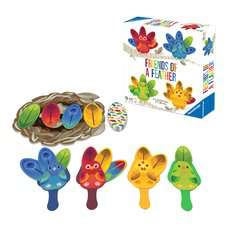I occasionally get games from publishers that are beyond what I typically play and review – my focus for Paste is strategy games, and if you include social deduction games in that, you’ve got just about everything I play, too. I don’t do RPGs, for example (cough-Gloomhaven-cough), and I don’t play the straight party games that often show up in my mailbox. I do, however, find myself playing a few more games that are aimed just at younger kids lately, and have three I can recommend if you’re looking for gifts for the little ones. These are games you’d never play except with young kids.
Friends of a Feather, from Ravensburger, is aimed at the youngest players – ages 3 and up – and has incredibly simple rules and goals. Each player gets a bird (which looks a bit like a table tennis paddle) and will try to gather feathers in their own matching color, taking them one at a time from the nest in the center or trading in two at a time for a matching pair. There are four colors plus “rainbow” feathers that are wild, although I have found kids like those so much they may try to gather those above all else. I played this with a smart three-year-old and she had no problem understanding the rules or the goal, and kept showing off her panoply of feathers.

The Furglars, from Bananagrams, is a dice-rolling game with a very light dice-drafting mechanic. The dice have four different symbols on their six sides: the furglar monster symbols, locks, hands (for picking locks and stealing dice), or blanks. On your turn, you roll all of the dice that aren’t stored as furglars on someone’s card, and then choose which dice to keep. You can buy point cards with furglars, spending 1/2/3/4 dice for 1/2/4/7 points, or you can keep up to 3 furglars, and may protect any of them with locks, one die with a lock showing per furglar die. You can also use one hand die to steal an unprotected furglar from an opponent, or to pick and remove a lock protecting someone else’s furglar. The point goal to win the game varies with player count but it’s 15 for four players, which really doesn’t take very long. The only rule that is a bit tricky for younger players involves how the locks work: You need one per furglar you’re protecting, but on their next turn, they keep the furglar dice but must re-roll the locks.
Catlantis, also from Ravensburger and designed by the Prospero Hall collective (Villainous, Kero), is a silly card-matching game listed for players 8 and up but really playable with younger kids, at least down to age 6. The deck mostly comprises cards that show these Dr. Moreau-level cat/mermaid hybrids, with five cats and five mermaid tails mixed up in all 25 potential combinations. At the start of the game, each player is randomly assigned a cat and a tail and must try to collect as many cards as possible that match those. The gimmick here is how you get cards: There is a rolling market of four cards at all times, and on your turn, you pick any two of those cards and offer them to an opponent, who must pick one, leaving you with the other one. A full round involves each player making such offers to all opponents, after which the round resets. The deck also has three types of treasure cards, which become more valuable the more you collect a specific treasure; and a few cards worth straight points. That card-drafting mechanic is a little weird and certainly not intuitive, especially in the sense of knowing what cards to pick so that your opponent takes the one you don’t want and leaves you with the one you do, but the kids with whom I’ve played this like the silly art and theme. Younger players may need reminders to check their cat and tail cards to ensure they keep matching the correct ones. My one issue with the game is its length – we have always had to cut the game short rather than complete the entire deck because someone, and not always one of the kids playing, started to lose interest.